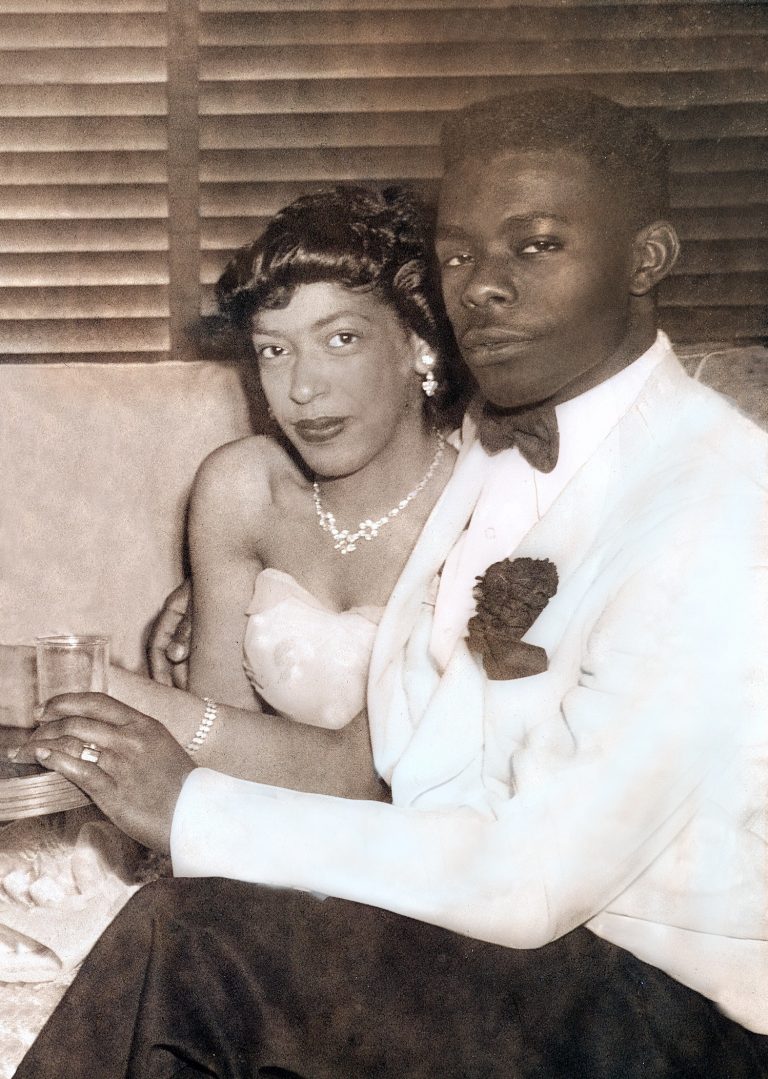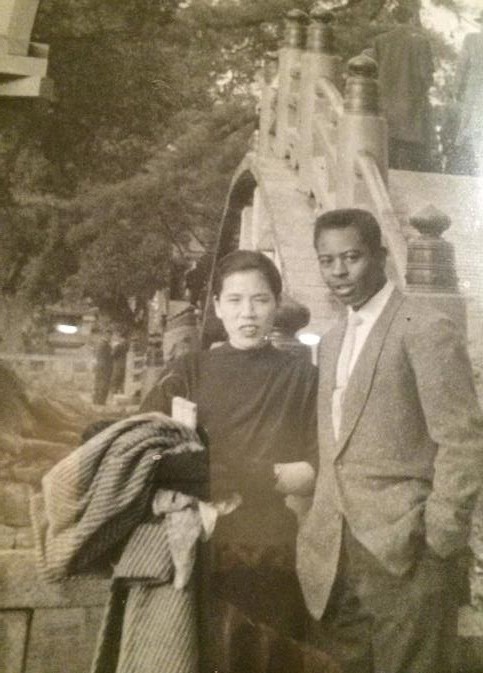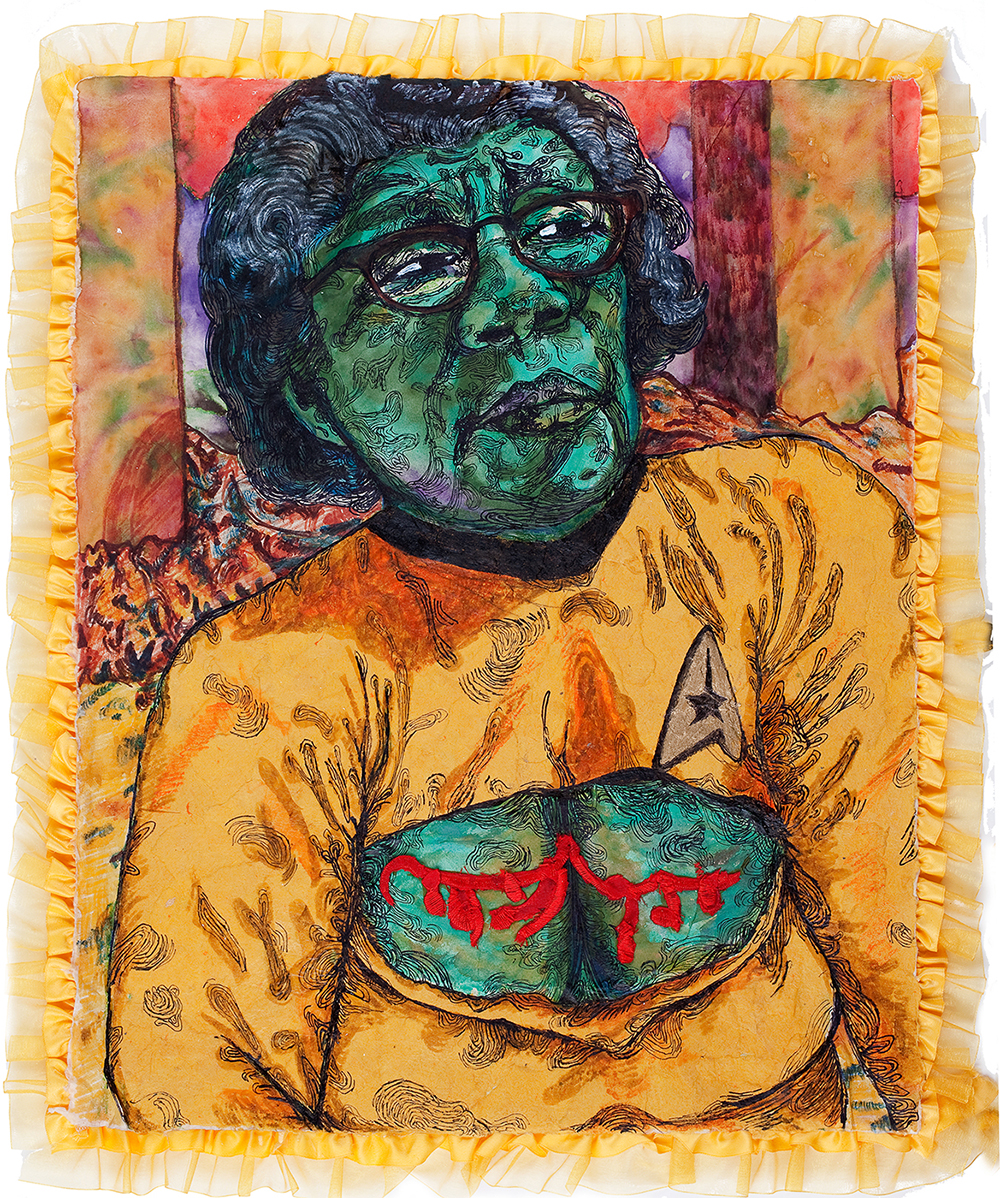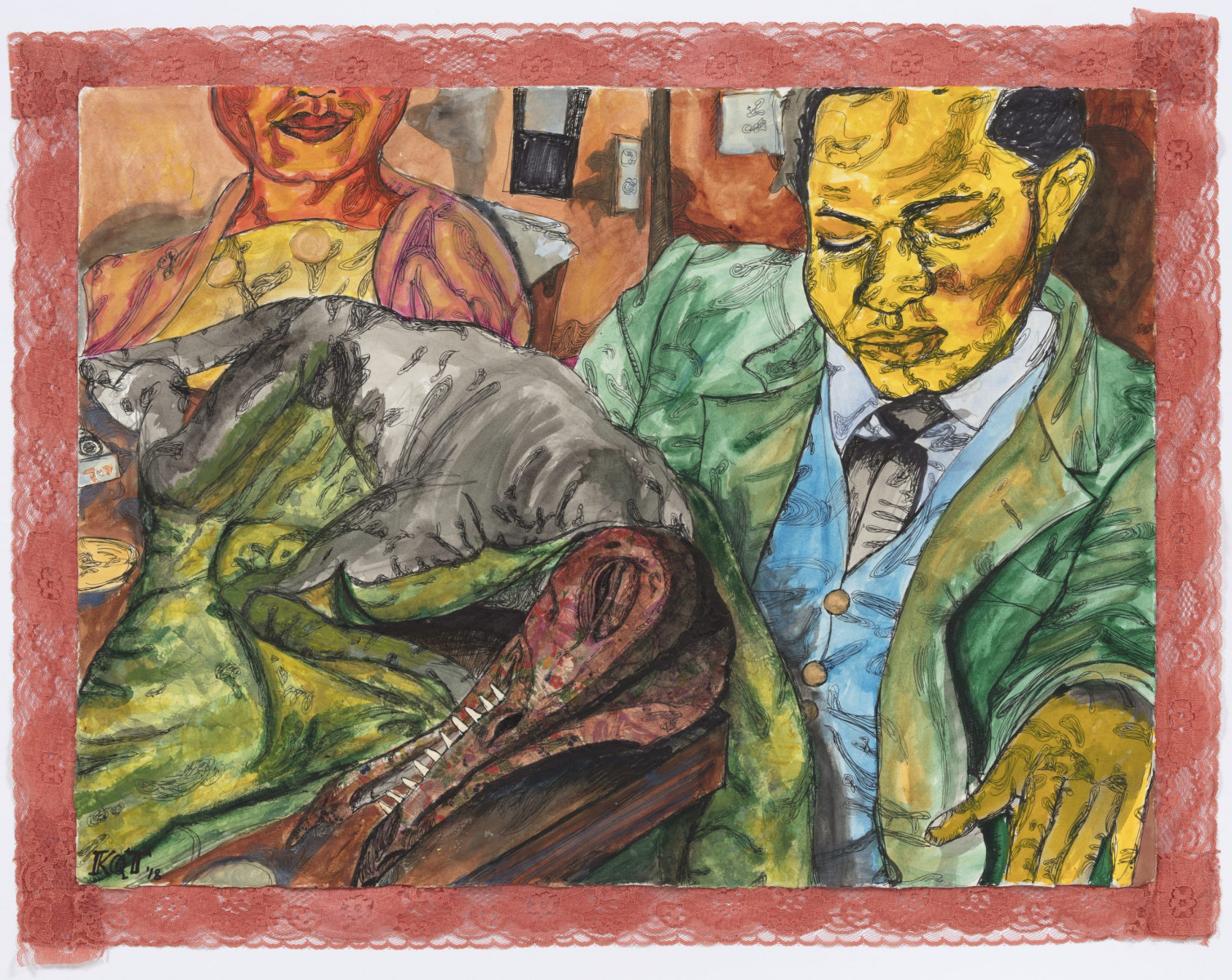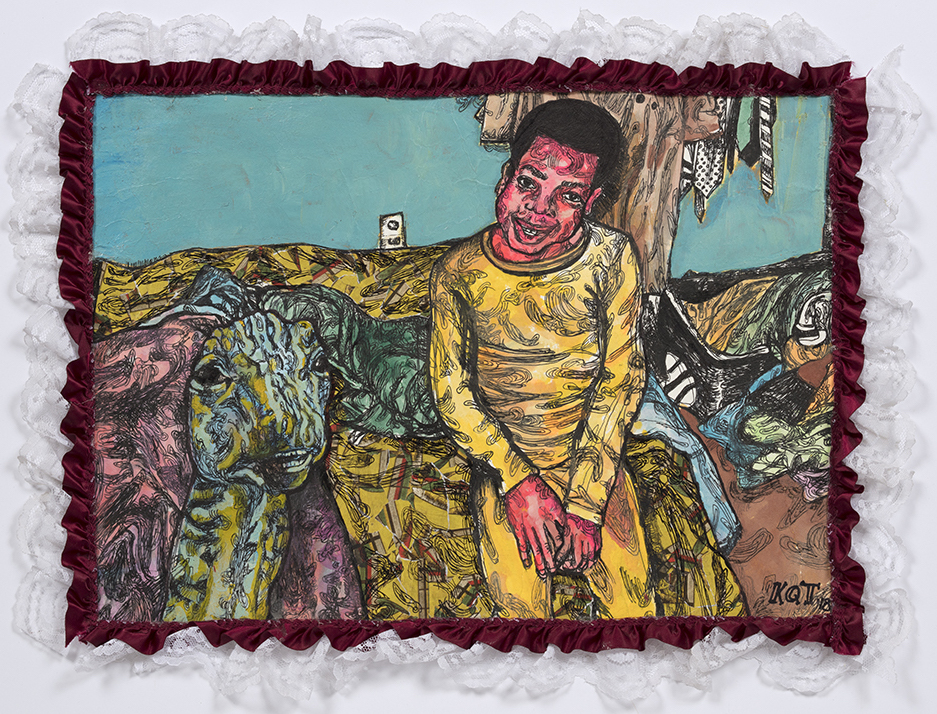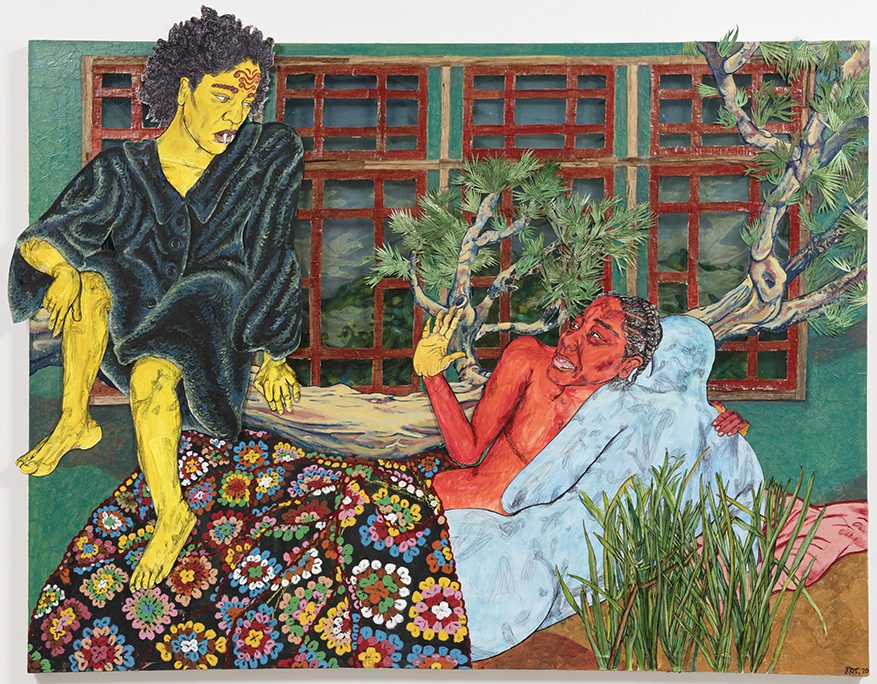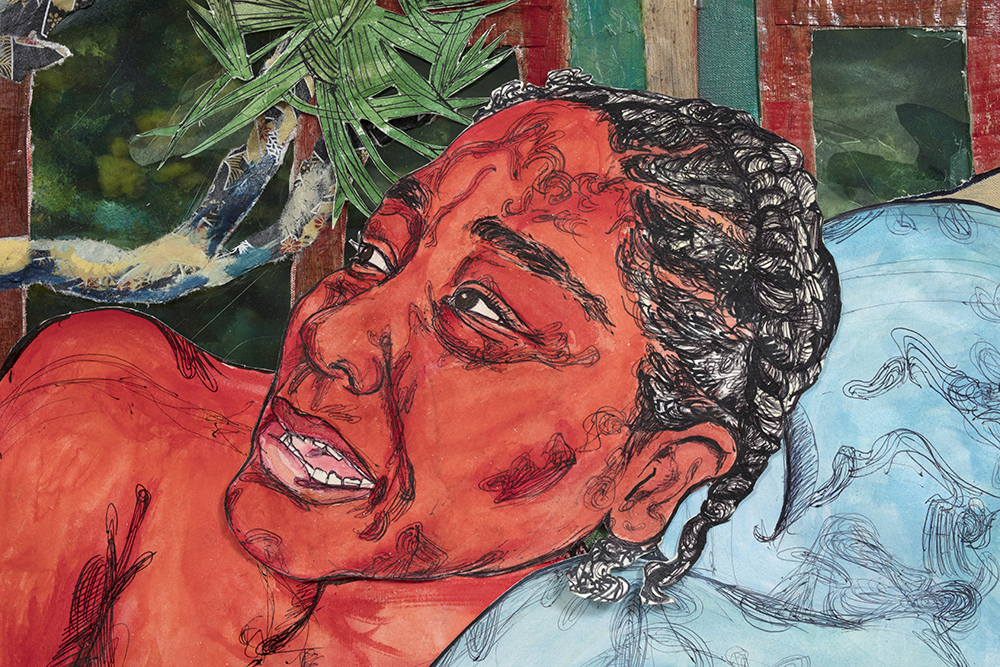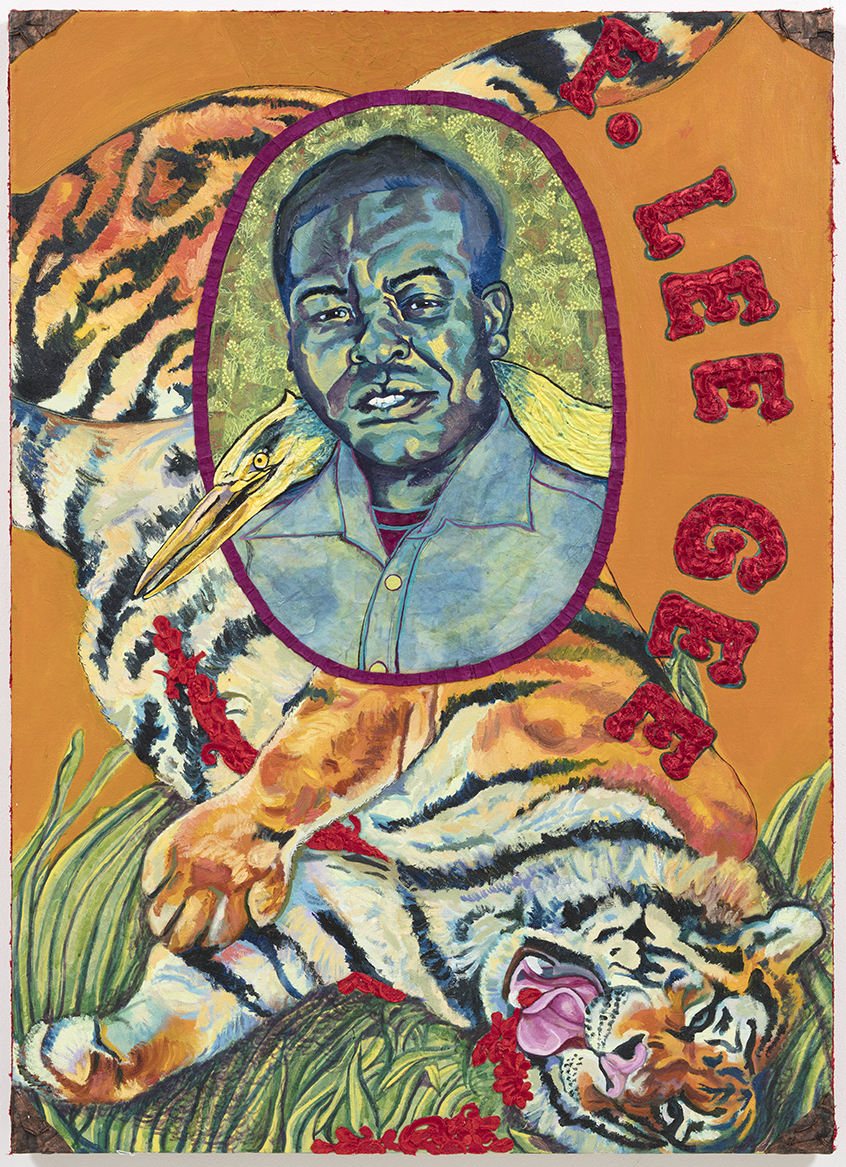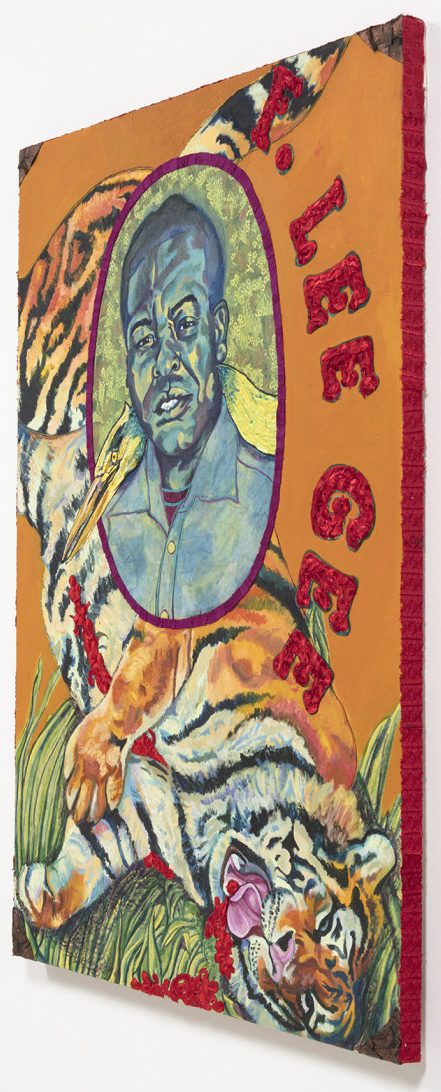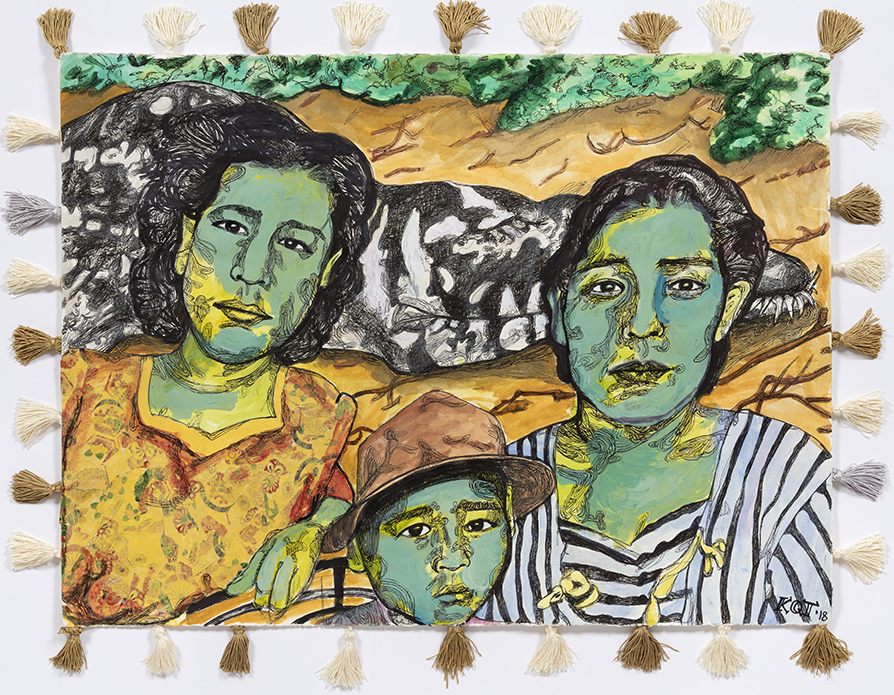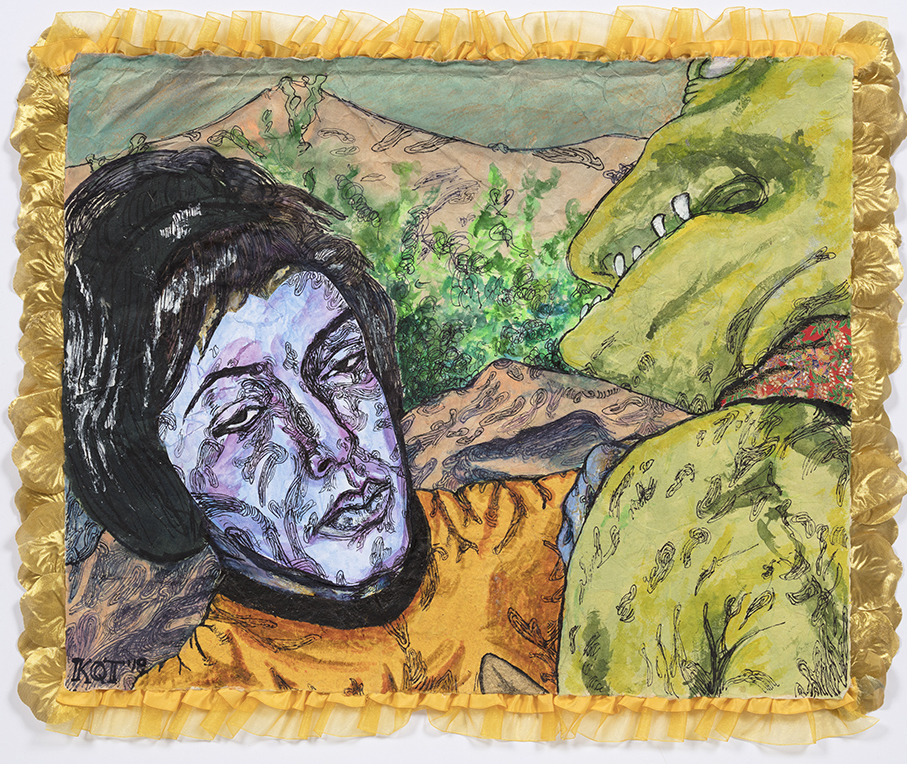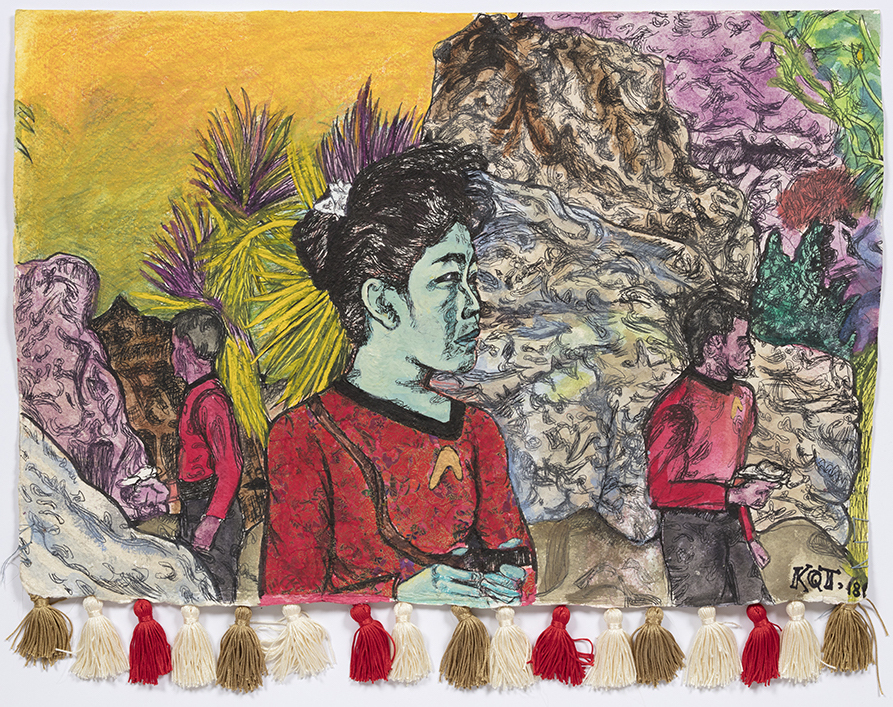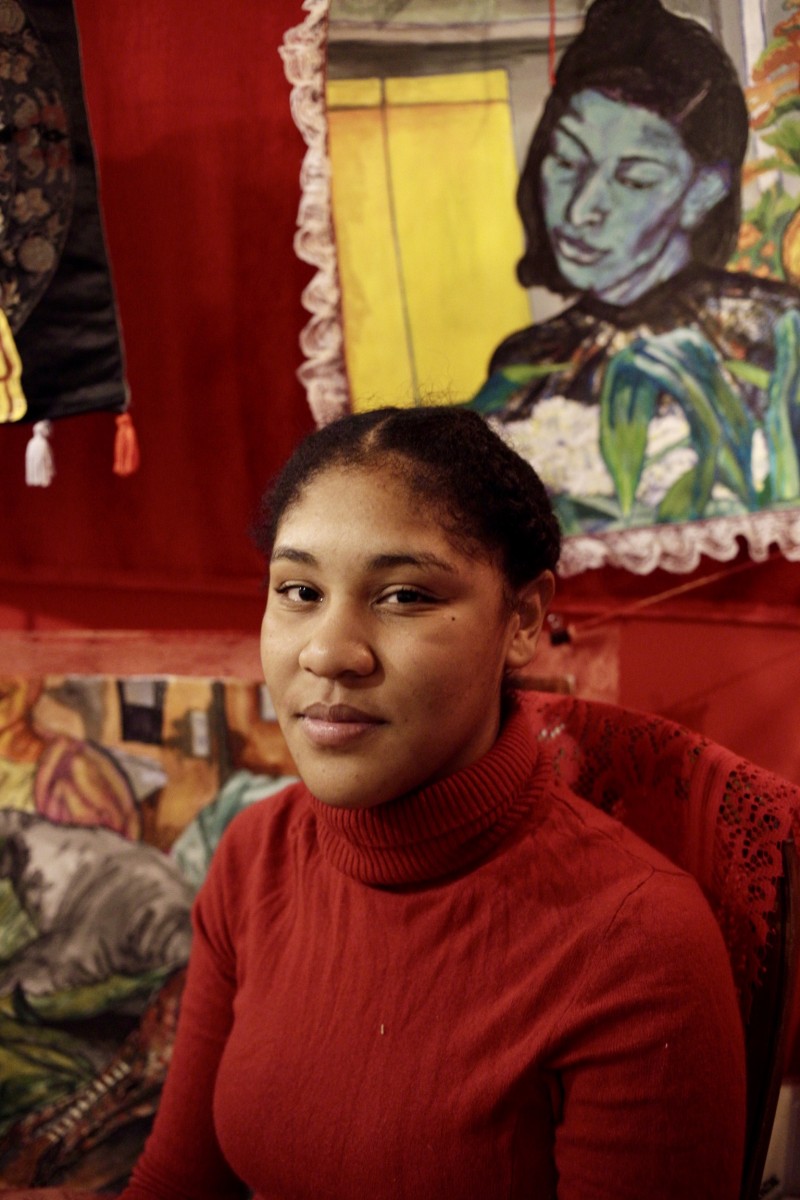
Steve Turner is pleased to present Dream Logic, a solo online exhibition featuring recent works by New York-based Kiyomi Quinn Taylor. Taylor combines drawing, painting and collage to form narratives which conflate family history with dinosaurs and Star Trek. Taylor utilizes an archive of family photographs from the 1950s to 1970s which features African American relatives in New York, and Washington State and Japanese ones in Fukuoka, Japan. All four of her grandparents are frequently featured in her work because she sees them “as the genetic contributors and the emotional shapers of my parents’ psyches – the characters responsible for the creation of my world.” By combining drawings based on family photographs with dinosaurs or scenes from Star Trek, Taylor equates dinosaurs with anxiety, one that relates both to the uncertainty of the future and the brutality of the past; Star Trek represents the magic of a future fantasy. By juxtaposing emotionally-charged fictional and factual imagery, Taylor collapses time along psychic, genetic, and poetic lines.
Kiyomi Quinn Taylor (born 1995, South Orange, New Jersey) received a BFA from New York University (2017) and an MFA from Columbia University (2020). She has presented work in group exhibitions since 2016. Dream Logic is her first solo exhibition at Steve Turner.
A Conversation Between
Kiyomi Quinn Taylor
&
Aino Frilander
September 2020
Aino Frilander
Under any other conditions you’d be a recent MFA grad from Columbia, but because of this chaotic year, you and your cohorts have postponed your thesis exhibition until next year. Aside from the weirdness of this year, what was the MFA experience like for you?
Kiyomi Quinn Taylor
I really, really enjoyed my MFA experience. It was busy, critical, overwhelming, a lot of fun. I have so much respect for all my peers at Columbia. So much that it crosses over to pride! This might be more or less important but I also happen to like them a lot. It was a wonderful thing to be immersed for almost two years in a community of artists, just talking to one another about art and ideas. It was one big, long, complicated discussion. I think I grew, as an artist and a person.
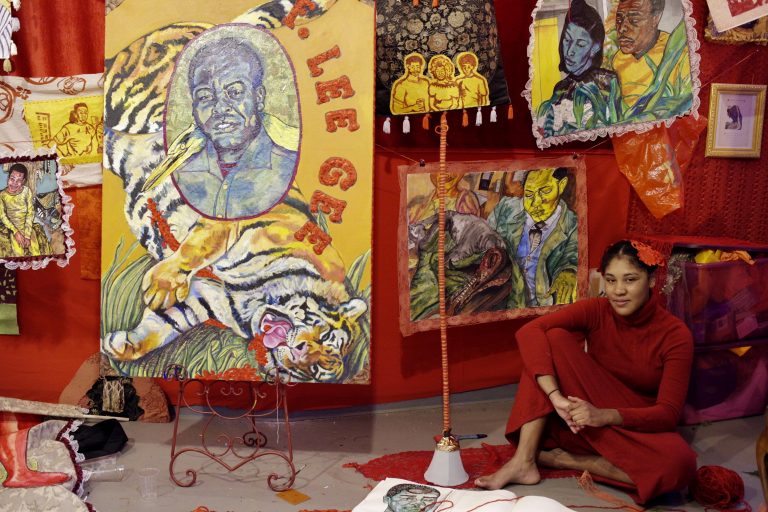
AF
What originally led you to pursue an MFA? And what led you to pursue art initially?
KQT
When I left high school I actually wasn’t sure that I wanted to study art. I enjoyed art and used my time outside of school and sports to create. I was always sketching my friends and family. But I think I was afraid. I ended up applying to a single art program – at NYU – that I really wanted to go to. I told myself that if I got into that program I would study art, and if not, I would go somewhere else and do something else. I got into that program and immediately felt like there was nothing else that I could ever do with my life.
The teachers there were really pivotal for my commitment to art as a career and a lifestyle. I decided to pursue my MFA soon after because I had such an enriching time and because I recognized that an MFA could help me become a university educator. Then I would never have to leave academia.
AF
Do you still have plans to return to academia, or are you focused on producing your own work for now?
KQT
Right now I am focused on producing my own work. But I hope to become a teacher at some point and experience the kind of relationships that I’ve enjoyed with my teachers, this time from the other side.
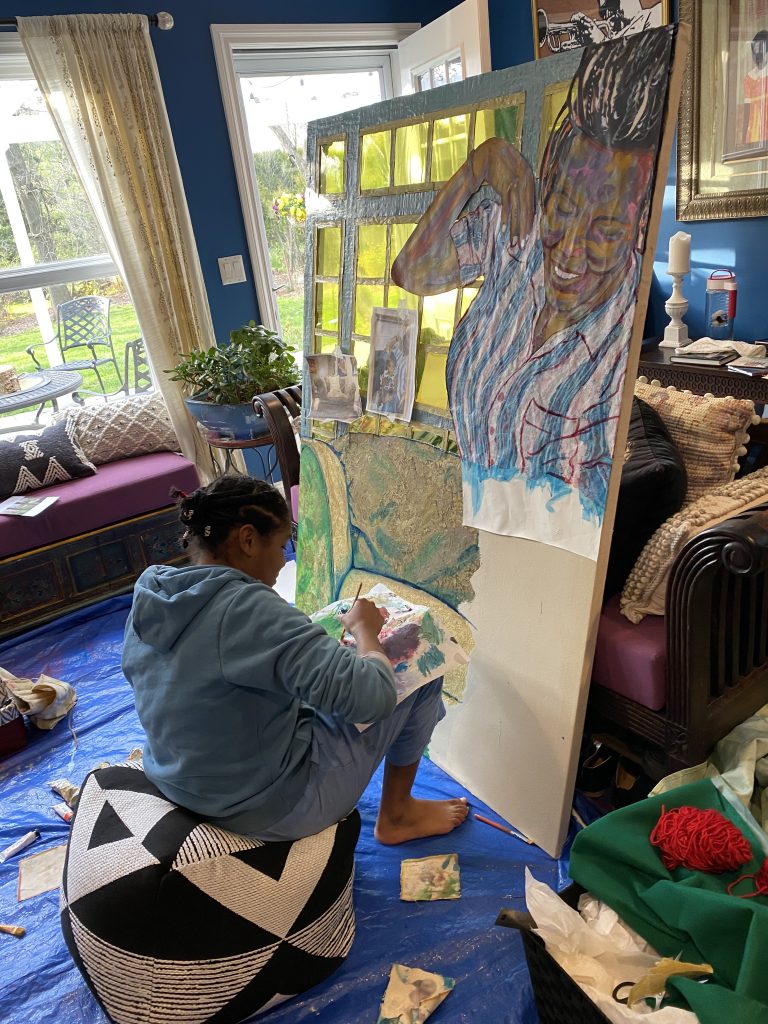
AF
You’re currently living between Harlem, where you have an apartment, and your parents’ house in New Jersey, where you’ve set up your studio. Apart from the rent being much lower than in Red Hook, can you talk to me about the perks of working at your parents’ place? 🙂
KQT
Apart from not having to pay rent working in my parents’ garage, I am lucky to have access to the archive of family photographs collected and kept by my parents. These old family photographs from the 50’s, 60’s, and 70’s, taken in upstate New York, Fukuoka in Japan, and Washington State, fired up my imagination about the past, and about these characters who were larger-than-life to me since I was very little. In addition, I have access to my parents themselves, both of whom have great anecdotes and memories about my grandparents, my great-grandparents and their own siblings, most of whom I have never met, but who look like them. Not to mention some free home-cooked meals throughout the week! I deeply miss working in close proximity to my classmates, but it’s a pretty sweet deal.
AF
Red Hook definitely can’t compete with that! What was life like growing up?
KQT
The area I grew up in is a suburb in Northern New Jersey. We affectionately call it “Mapso” as Maplewood and South Orange are the two towns that feed into our local high school. Many of my classmates’ parents lived in New York prior to moving to our area, and many had art-related jobs in the city or were artists – photographers, dancers – or worked on Broadway. Maybe that’s why it didn’t seem impossible to follow one’s creative dreams. My school, Columbia High School, had a lot of art programs. My parents both had corporate jobs but maintained a creative lifestyle outside of that. My mom has sung in bands all her life. She used to sing at jazz clubs in New York in the 80s. My dad played in bands all through high school and college. He plays the keyboard. They released an R&B album together with some of their musical friends in the early 90s. There was always live music and singing in the house. My mom also used to make these collages when I was little, with spray paint and fern leaves and stamps. Watching them make time to express themselves despite their already busy lives, not as a way to make money but as a necessity, a way to communicate, and a way of creating a loving, comfortable home, was hugely formative for me.
AF
You sing too, right?
KQT
I do sing, not professionally, but I love it and I’ve always loved it. I regularly sing and make music with my friends. For open studios at Columbia last year, I performed improvisational music with four friends for three hours inside an installation that I made. And I sing with my mom, too. I sing mostly background in her band, a local funk and soul cover band that has now also written a few originals. They’re called “Essex Funk.”
AF
When all this covid madness is over, I want to hear you! Do you feel like there are similarities for you between singing and making visual art?
KQT
Although there are similarities, I feel like I tend to celebrate the differences more. I enjoy the instantaneousness of singing. You have to be in the moment. The same is definitely true of painting or drawing, in that with pen or brush in hand, in communication with a surface, you are performing something instantaneous, the results of which will be perceived later by some sort of audience.
That being said, the performance that I do in the studio when creating visual work is mostly additive – hours and hours of work that I have done by myself. What I enjoy about singing that I don’t feel I always get from painting or drawing, is a necessary reliance on and connection with other people. Musicians need to accompany the vocalists and vice versa, and an audience must listen to and engage with the music.
AF
Your family, especially your grandparents, is prominently featured in your paintings. Who were they and why do you feature them in your work?
KQT
I never met either of my grandfathers. That alone has contributed a lot to the mystery and drama of their lives for me. My grandmothers were both powerful people. I knew them in their final years. All four of my grandparents are central to my work because I see them as the genetic contributors and the emotional shapers of my parents’ psyches. They are responsible for the creation of my world. Their lives read like fiction to me. My maternal grandmother was disowned by her wealthy, Japanese family for marrying my grandfather, a black military man from Arkansas. She was a strong swimmer who would swim a mile in the ocean every morning. He was a man with an impeccable memory who spoke eight languages, a poet who wrote reams and reams of thick depressive poetry. He also was a highly functioning alcoholic. At times, my grandmother had to raise my mom and her sisters alone because he was stationed overseas.
My paternal grandmother and grandfather met at fifteen at a roller skating rink in New Jersey. They were on and off for forty years until my grandfather was killed by a drunk driver. He owned a bar called “The Royale,” as well as a custodial business, and often drove drunk himself. My grandmother was honest and quippy, and had a famous pair of hips.
I make work about my family, and my grandparents in particular, because their story has a poetic quality and drama that I love. The characters are the stuff of folklore.
AF
What a wealth of stories to mine! It almost sounds like a sprawling novel, or several.
KQT
It’s so funny that you say that. I think of these stories as a sprawling novel or a series of interconnected novels. I actually think of these family stories as a “blood bridge.”
"I think of these stories as a sprawling novel or a series of interconnected novels. I actually think of these family stories as a “blood bridge.”"
AF
It feels like you put a lot of care and love into your work, almost like an offering to your ancestors. Does that thought resonate with you at all?
KQT
That definitely resonates with me. I think of a lot of my paintings as communion with the dead. They’re intended to ask questions, to seek guidance and to address traumas of the past. I put forth the labor and devotion with that in mind.
AF
I understand that you’ll be showing a painting featuring your grandfather at Steve Turner in October. What else will you present?
KQT
In addition to the painting of my grandfather, I am showing a series of works that I think of as “time collages.” They are mixed media drawings based on family photographs combined with depictions of dinosaurs or scenes from Star Trek. Fictional futures and a true but often fictionalized past are all mixed up with the people from my family. I am thinking about a supernatural sense of time collapse within a family, one that is psychic, genetic, emotional and poetic.
I am also showing a painting that I finished earlier this year that would have been the cornerstone of my thesis show way back in April if not for the pandemic, “Gorilla, My Love.” It’s the largest painting I have made yet – five by seven feet. I finished it in my parents’ garage after evacuating the school studios.
AF
Can you tell me a little bit more about “Gorilla, My Love?”
KQT
The title is based on the title of a Toni Cade Bambara short story and it is about internal conflict. It pictures me in two conflicting parts, one in red and one in yellow. It’s an image about confusing and draining moments in one’s personal life and love life. Sometimes my paintings operate as a way to process and work through specific issues and dramas in my own inner life.
"I am thinking about a supernatural sense of time collapse within a family, one that is psychic, genetic, emotional and poetic."
AF
I’ve been itching to get to this. Can you talk to me about dinosaurs? Also about Star Trek, and fantasy novels, but first and foremost about dinosaurs: why do you feature them in your work?
KQT
I used to have a lot of nightmares about dinosaurs. That planted them firmly in my psyche. A lot of my work involves creating or finding allegorical imagery that defines complicated emotions. I think dinosaurs represent anxiety, anxiety about the future and anxiety about the brutality of the past. They represent the brutalities of the past that you know and that you live with, those that will produce more if you leave them unaddressed. The anxiety about the future is about the fear of a failure that is beyond repair–the fear of extinction.
My dad was a big Star Trek fan as a kid. I love to think about how that gorgeous, colorful, theatrical story of the future is a creation of the past, the 1960s in particular, when my parents were children, when they were most imaginative and most receptive to magic.
I read a lot of sci-fi novels and short stories with my brother when I was younger. The episodic structure and the imagery in Star Trek really captures the feeling of reading those stories. The fact that my father watched so much of Star Trek as a kid, just as I did at the same age thirty years later, is symbolic of the “time collapse” across generations that I tend to think about in the studio.
"A lot of my work involves creating or finding allegorical imagery that defines complicated emotions."
AF
I love that idea of a time collapse. The dinosaurs remind me of how you describe yourself as “small and scared.” What are you scared of? And what is it about art that makes you feel fearless?
KQT
I’m small and I find myself constantly overwhelmed by the scope of time and space. I think we are all small. I’m anxious about my loved ones, anxious about the passing of the time, about my own thoughts and feelings, about the future of the world, about my own personal future. I usually don’t feel very in control.
Art makes me feel fearless because I am in charge of the passing of the time, the care for my loved ones in my work, the amount of time spent, the shape and color of every line. I am the one telling the story, so suddenly I go from having no control to having all of it.
Please direct inquiries to:
steve@steveturner.la
jonathan@steveturner.la


